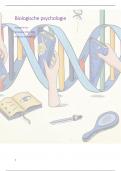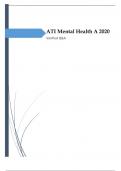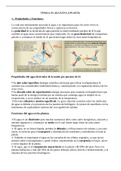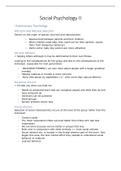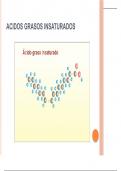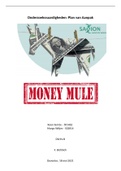1 Inleidende begrippen: organisatie, organisatieontwerp en strategie .......................................................7
1.1 Wat is een organisatie? .......................................................................................................................7
1.2 Belang van organisaties.......................................................................................................................7
1.3 Context van organisaties .....................................................................................................................7
1.4 Fundamentele designprincipes ...........................................................................................................8
1.5 Organisatiedoel ...................................................................................................................................8
1.5.1 Vereenvoudigde typologie: ..........................................................................................................8
1.6 Strategie ..............................................................................................................................................8
1.6.1 Strategietypologiën:.....................................................................................................................8
1.6.1.1 Michael Porter ...................................................................................................................................... 8
1.6.1.2 Miles & Snow (1978) ............................................................................................................................. 9
1.7 Strategie – organisatie: voorbeeld Apple............................................................................................9
1.8 Structure follows strategy .................................................................................................................10
1.8.1 Strategie en organisatieontwerp: complexere relatie/ .............................................................10
1.8.2 Wisselwerking tussen elementen ..............................................................................................10
1.9 Organisatieontwerp: dimensies ........................................................................................................11
1.9.1 Organogram ...............................................................................................................................11
1.9.2 Typische lagen ............................................................................................................................11
1.9.3 Interactie ....................................................................................................................................11
1.10 Optimaal organisatieontwerp .......................................................................................................12
1.10.1 Case: Acme en Omega: ..............................................................................................................12
1.11 Twee extremen ..............................................................................................................................12
2 De mechanistische organisatieprincipes .................................................................................................13
2.1 Taylor als grondlegger .......................................................................................................................14
2.2 Fayol als grondlegger ........................................................................................................................14
2.3 Mechanistische organisatie: basismechanismen ..............................................................................14
2.4 Palmares van de mechanistische organisatie: Ford als voorbeeld ...................................................14
2.5 Evaluatie: sterke punten ...................................................................................................................14
2.6 Toepassing Hudsucker Proxy.............................................................................................................15
2.7 Mechanistische organisatiekeuze .....................................................................................................15
2.8 Voordelen van de hiërarchie .............................................................................................................15
2.8.1 Case ACME en OMEGA ..............................................................................................................15
3 Evolutie naar meer organische organisatieprincipes ..............................................................................16
3.1 Mechanistische organisatie onder druk ............................................................................................16
3.1.1 Verklaring negatieve kenmerken van mechanistische organisatiekeuze..................................16
3.1.2 Span of control ...........................................................................................................................16
3.2 Hawthorne Studies ............................................................................................................................16
3.2.1 Elton Mayo (1880-1949): human relations................................................................................17
1
, 3.2.2 Chester Barnard (1886-1961): “The functions of the executive” (boek 1938)..........................17
3.2.3 Gevolg: bewegingen om hiërarchie te beperken ......................................................................17
3.3 Nieuwe trends of omstandigheden voor organisaties op vandaag ..................................................17
3.3.1 Globalisering ..............................................................................................................................17
3.3.2 Hypercompetitie ........................................................................................................................17
3.3.3 Nieuwe technologieën ...............................................................................................................18
3.3.4 Kenniseconomie.........................................................................................................................18
3.3.5 Sociale verantwoordelijkheid ....................................................................................................18
3.3.6 Gevolg ........................................................................................................................................18
3.4 Contingentietheorie ..........................................................................................................................18
3.4.1 Organisatie: een open systeem .................................................................................................18
3.4.2 T. Burns en G. Stalker (1961) .....................................................................................................18
3.4.2.1 Onderzoek ........................................................................................................................................... 19
3.4.2.2 Mechanistische en organische organisatievormen ............................................................................ 19
3.4.2.3 Technologie ......................................................................................................................................... 19
3.4.2.4 Joan Woodward (1965): technologie als contingentiefactor.............................................................. 19
3.4.2.5 Taakomgeving en differentiatie (Lawrence en Lorsch, 1967) ............................................................. 20
3.4.2.6 Onzekerheid van omgeving en integratie/differentiatie .................................................................... 20
3.4.2.7 Verschillen tussen afdelingen ............................................................................................................. 21
3.4.2.8 Structurele verschillen ........................................................................................................................ 21
3.5 Omgeving: domein ............................................................................................................................22
3.5.1 Taakomgeving/specifieke omgeving .........................................................................................22
3.5.2 Algemene omgeving ..................................................................................................................22
3.5.3 Onzekerheid in de omgeving .....................................................................................................22
3.5.4 Dimensies van de omgeving ......................................................................................................22
3.5.4.1 Omgevingsonzekerheid: kader ........................................................................................................... 23
3.5.4.2 Omgaan met onzekerheid................................................................................................................... 23
3.5.4.3 Achtergrond: informatieverwerking ................................................................................................... 24
3.5.4.4 Organische structuren? ....................................................................................................................... 24
3.5.4.5 Onzekerheid: extra factor RESOURCES ............................................................................................... 24
3.5.4.6 Resource dependence theorie ............................................................................................................ 25
3.5.4.7 Domeincontrole .................................................................................................................................. 25
• Domein aanpassen: ..................................................................................................................................... 25
o Overnames .................................................................................................................................................. 25
o Devesteringen ............................................................................................................................................. 25
o Politieke aanpak .......................................................................................................................................... 25
• Handelsassociaties (lobbying, … ................................................................................................................. 25
• Illegale activiteiten (omkoping, …) .............................................................................................................. 25
3.5.4.8 Sterke punten van contingentiedenken.............................................................................................. 25
2
, • Relatie met de omgeving ............................................................................................................................ 25
• Er zijn meerdere behoeftes: belang van evenwicht ................................................................................... 25
• Er is niet één type organisatie: keuzes noodzakelijk, in lijn met de contingenties (equifinaliteit) ............. 25
• Organisatieanalyse ...................................................................................................................................... 25
• Innovatie en flexibiliteit .............................................................................................................................. 25
3.5.4.9 Zwakke punten contigentiedenken .................................................................................................... 25
4 Complexere context: interorganisationele organisaties .........................................................................26
4.1 Voorbeelden ......................................................................................................................................26
4.2 Drijfveer: onzekerheid in de omgeving .............................................................................................26
4.3 Ondersteunende theorieën ..............................................................................................................26
4.3.1 Resource dependence theorie= zaken wat men nodig heeft voor de eigen organisatie = vb 1
26
4.3.1.1 Types ................................................................................................................................................... 26
4.3.1.2 Verbindingsmechanismen................................................................................................................... 27
4.3.1.3 Strategieën voor symbiotische interpendenties ................................................................................. 27
4.3.1.4 Strategieën voor competitieve interpendenties ................................................................................. 27
4.3.2 Collaboratieve Netwerken theorie = willen maar moeten niet samenwerken = vb 2 ..............28
4.3.2.1 Veranderende aard van interorganisationele relaties ........................................................................ 28
4.3.3 Institutionele theorie = maatschappelijke verwachting (“moeten wel”) = vb 3 .......................29
4.3.3.1 Stakeholdersanalyse: Mendelow’s matrix .......................................................................................... 29
4.3.3.2 Institutioneel perspectief en organisatieontwerp .............................................................................. 29
4.3.3.3 Institutionele aanpassingen ................................................................................................................ 30
4.4 Transactiekostentheorie ...................................................................................................................30
4.4.1 Bronnen van transactiekosten ...................................................................................................30
4.4.2 Transactiekosten in de organisatie ............................................................................................31
4.4.3 Transactiekostentheorie en interoganisationele relaties ..........................................................31
4.5 Wijzigend competitief landschap. .....................................................................................................31
4.5.1 Organisatieontwerp en interoganisationele relaties .................................................................31
5 Organisatiestructuren- en ontwerp .........................................................................................................32
5.1 Enkele conclusies: .............................................................................................................................32
5.2 Organogram ......................................................................................................................................32
5.3 Informatieverwekkend perspectief op structuur: integratie ............................................................32
5.4 Nood aan integratie ..........................................................................................................................33
5.5 Configuraties van Henry Mintzberg (1979) .......................................................................................34
5.5.1 Mintzberg: vijf elementen/structuuronderdelen ......................................................................34
5.5.2 Coördinatiemechanismen ..........................................................................................................34
5.5.3 Organisatieconfiguraties ............................................................................................................34
5.6 Overzicht structuren .........................................................................................................................35
5.6.1 1a Machineorganisatie (MINTZBERG) .......................................................................................35
3
, 5.6.2 1b Functionele structuur (F-grouping) → FOS...........................................................................35
5.6.3 2a. Divisiestructuur (Mintzberg) ................................................................................................36
5.6.4 2b. Integratie via divisiestructuur ..............................................................................................37
5.6.5 3a. Adhocaratie ..........................................................................................................................37
5.6.6 3b. Integratie via projectstructuur.............................................................................................38
5.6.7 3b. Multifocused grouping: matrixstructuur .............................................................................38
5.6.8 4. Multifocused grouping: hybride structuur ............................................................................39
5.6.9 5. Horizontale structuur .............................................................................................................39
5.6.10 6. Virtuele netwerkstructuur .....................................................................................................39
5.6.11 7. Eenvoudige structuur .............................................................................................................40
5.6.12 8. Professionele organisatie .......................................................................................................40
5.7 Toepassingen.....................................................................................................................................41
5.7.1 Organisatieontwerp toegepast ..................................................................................................41
5.7.2 Overzicht ....................................................................................................................................41
5.7.3 Voorbeelden toepassingen slides ..............................................................................................41
5.8 Internationaal organiseren................................................................................................................42
5.8.1 Internationale context ...............................................................................................................42
5.8.2 Motieven voor buitenlandse expansie ......................................................................................42
5.8.3 Organisationele uitdaging ..........................................................................................................42
5.8.4 Internationale strategie .............................................................................................................42
5.8.5 Structuur en strategie ................................................................................................................43
6 Controle, jobdesign en personeelssysteem .............................................................................................44
6.1 Wat is controle? ................................................................................................................................44
6.1.1 Prospectieve en reactieve controle ...........................................................................................44
6.2 Controle en macht.............................................................................................................................44
6.3 Inspiratiebronnen voor controle .......................................................................................................44
6.3.1 3a. Jeremy Bentham → elimineren ...........................................................................................44
6.3.2 3b. Mary P. Follett – Dynamic Administration (1941) → samenwerken ..................................45
6.4 Controlestrategieën ..........................................................................................................................45
6.4.1 OUCHI (1979, 1980) ...................................................................................................................45
6.4.2 Burton et al. (2012) ....................................................................................................................45
6.4.3 CHILD (2005) ..............................................................................................................................46
6.4.3.1 Persoonlijke en gecentraliseerde controle ......................................................................................... 46
6.4.3.2 Bureaucratische controle .................................................................................................................... 46
6.4.3.3 Controle via elektronische surveillantie.............................................................................................. 46
6.4.3.4 Outputcontrole ................................................................................................................................... 46
6.4.3.5 HRM controle ...................................................................................................................................... 46
6.4.3.6 Culturele controle ............................................................................................................................... 46
6.5 VIDEOCASE DISNEY............................................................................................................................48
4


